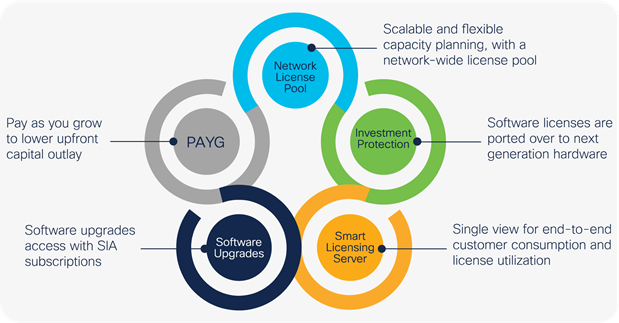Cisco IOS XR Flexible Consumption Model Overview
Available Languages
Bias-Free Language
The documentation set for this product strives to use bias-free language. For the purposes of this documentation set, bias-free is defined as language that does not imply discrimination based on age, disability, gender, racial identity, ethnic identity, sexual orientation, socioeconomic status, and intersectionality. Exceptions may be present in the documentation due to language that is hardcoded in the user interfaces of the product software, language used based on RFP documentation, or language that is used by a referenced third-party product. Learn more about how Cisco is using Inclusive Language.
Cisco IOS XR flexible consumption model overview
In today’s world, customers desire a simple and flexible way to purchase software capacity as and when needed. Cisco designed the new Cisco IOS XR Flexible Consumption Model (FCM) to specifically address customer outcomes and help customers rapidly deploy innovative new network solutions.

● Reduce upfront capital – The Cisco® Flexible Consumption Model is a Pay-as-You-Grow (PAYG) commercial offering that greatly reduces initial deployment costs, while providing the ability to add port capacity as networks organically grow
● Software upgrades – Continued access to new features with software upgrades and enhancements to existing features with SIA licenses and renewals
● Utilize capital efficiently – FCM supports pooling in a network-wide license pool, reducing the need for new licenses as your network expands and contracts to meet changing market demands
● Simplify operations – Using the two-tier license suites, Essentials and Advantage Software, simplify your license management while still providing the carrier-class Cisco IOS® XR Software feature set
● Protect your investment – By enabling perpetual software Right-to-Use (RTU) licenses to be ported from one generation of hardware to the next.
The Cisco IOS XR Flexible Consumption Model is a commercial offer that permits customers to pay incrementally to expand capacity as demand for their consumer and business services rises. They want investment protection with portability of software across hardware resources to meet demand across any one of their markets. Customers also want a software license management experience that enables porting of licenses across the corporation to shift capacity to markets in demand. Pay-as-you-grow commercial offers permit service providers to pool software licenses by lowering initial investments required to incubate new services and then invest in the network capacity as demand grows. Having this ability to add capacity as and when needed helps customers with their network and capacity planning.

The Cisco IOS XR Flexible Consumption Model software suites have been optimized for the:
FCM uses smart licensing to simplify the way end customers activate and manage their FCM licenses, allowing customers to have an easier, faster, and more consistent way to purchase, renew, or upgrade their licenses.
For information on the Cisco IOS Flexible Consumption Model systems and software licenses, contact your Cisco sales representative.
With the Flexible Consumption Model (FCM) lower your upfront investment, have continued access to software upgrades, and simplify your capacity planning!
Learn more about the Cisco IOS XR Flexible Consumption Model www.cisco.com/c/en/us/solutions/service-provider/flexible-consumption.html.